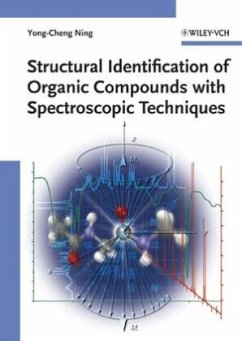Methodische Informationen und Anleitungen zur Spektreninterpretation unter einem Dach: In diesem Kompendium finden Sie alles, was Sie über die Strukturanalyse organischer Verbindungen mit spektroskopischen Methoden wissen müssen. Neben Standardverfahren (NMR, MS, IR, Raman) werden auch fortgeschrittene Neuentwicklungen wie PFG-NMR, LC-NMR, DOSY usw. vorgestellt. Nützlich für die Praxis sind die vielen Tricks und Kniffe, die der Autor aus der eigenen langjährigen Erfahrung schöpft. Ein ganzes Kapitel widmet sich der Konfigurations- und Konformationsbestimmung an organischen Verbindungen und Biomolekülen.
Clearly structured, easy to read and optimal to understand, this extensive compendium fills the gap between textbooks devoted to either spectra interpretation or basic physical principles. The original Chinese editions have already sold over 18,500 copies, and the material is taken from the latest literature from around the world, plus technical information provided by the manufacturers of spectroscopic instruments.
Alongside basic methods, Professor Ning presents up-to-date developments in NMR, MS, IR and Raman spectroscopy, such as pulsed-field gradient technique, LC-NMR, and DOSY. He stresses the application of spectroscopic methods, interpreting them in great detail and depth since most of the selected spectra may be applied to practical work, as well as summarizing the rules for their interpretation. He also incorporates his original ideas, including a comparison of the common points in different spectroscopic techniques.
This monograph features a unique structure, a typical example being the discussion of 2D NMR starting from pulse sequence units, which construct various pulse sequences for related 2D NMR. A complete chapter deals with the determination of configurations and conformations of organic compounds and even biological molecules from the viewpoint of spectroscopic methodologies, while one whole section is dedicated to the interpretation of mass spectra produced by soft ionization techniques.
The principles of mass analyzers, especially the ion trap, are discussed in great depth, together with a concise summary of the MS fragmentation and rearrangement of common compounds, allowing readers to easily predict related mass spectrometric reactions. All the three kinds of library retrieval of mass spectra are presented in detail, together with recent developments in molecular vibration spectroscopy. The whole is rounded off with several appendices, including a subject index for rapid reference.
With a foreword by the Nobel prizewinner, Richard R. Ernst.
Clearly structured, easy to read and optimal to understand, this extensive compendium fills the gap between textbooks devoted to either spectra interpretation or basic physical principles. The original Chinese editions have already sold over 18,500 copies, and the material is taken from the latest literature from around the world, plus technical information provided by the manufacturers of spectroscopic instruments.
Alongside basic methods, Professor Ning presents up-to-date developments in NMR, MS, IR and Raman spectroscopy, such as pulsed-field gradient technique, LC-NMR, and DOSY. He stresses the application of spectroscopic methods, interpreting them in great detail and depth since most of the selected spectra may be applied to practical work, as well as summarizing the rules for their interpretation. He also incorporates his original ideas, including a comparison of the common points in different spectroscopic techniques.
This monograph features a unique structure, a typical example being the discussion of 2D NMR starting from pulse sequence units, which construct various pulse sequences for related 2D NMR. A complete chapter deals with the determination of configurations and conformations of organic compounds and even biological molecules from the viewpoint of spectroscopic methodologies, while one whole section is dedicated to the interpretation of mass spectra produced by soft ionization techniques.
The principles of mass analyzers, especially the ion trap, are discussed in great depth, together with a concise summary of the MS fragmentation and rearrangement of common compounds, allowing readers to easily predict related mass spectrometric reactions. All the three kinds of library retrieval of mass spectra are presented in detail, together with recent developments in molecular vibration spectroscopy. The whole is rounded off with several appendices, including a subject index for rapid reference.
With a foreword by the Nobel prizewinner, Richard R. Ernst.

